Sprout Food vs Whole Food: Exploring the Health Differences. 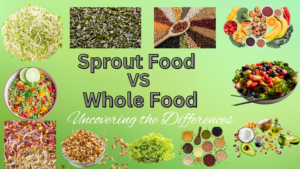
Introduction: Sprout Food vs Whole Food – Exploring the Health Differences
The debate between sprout food vs whole food is gaining traction as health-conscious consumers seek nutrient-dense dietary choices. Whole foods—such as grains, legumes, and seeds in their natural, unprocessed state—are celebrated for their fiber, vitamins, and minerals. Sprouted foods, created by germinating these whole foods, undergo biochemical changes that enhance their nutritional profile. When comparing sprout food vs whole food, key differences emerge: sprouting increases bioavailability of nutrients like iron and vitamin C while breaking down antinutrients like phytic acid, which can hinder digestion. This article dives into the science-backed health differences between sprout and whole foods, helping you decide which aligns best with your wellness goals.
The Best Nutritional Composition of Sprout Foods
Sprout Food vs Whole Food: Exploring the Health Differences.
Sprouts are rich in nutrients that are beneficial for your health. They are loaded with essential vitamins and minerals that your body needs. The nutritional value of sprouts is influenced by the type of seed used, the sprouting process, and how they are stored.
Sprouts are high in protein, fiber, and vitamins, making them an excellent choice for increasing protein intake. Their fiber content also aids in digestion. Additionally, sprouts provide essential minerals such as calcium and iron.
Sprout Food vs Whole Food: Exploring the Health Differences
The debate between sprout food and whole food is gaining momentum in nutrition. Both types of food are celebrated for their health benefits, but they serve different purposes and offer unique advantages. Whether you are a health enthusiast or just beginning your wellness journey, understanding the differences between sprout and whole foods can help you make informed dietary choices. Let’s dive into the details!
What is Sprout Food?
Sprout food refers to seeds, grains, or legumes germinating and being allowed to grow into young plants. Common examples include alfalfa, mung bean, broccoli, and lentil sprouts. Sprouting involves soaking the seeds in water until they grow tiny shoots.
Benefits of Sprout Food:
- sandwiches, and stir-fries.Increased Nutrient Density: Sprouting enhances the bioavailability of nutrients like vitamins, minerals, and antioxidants. For example, sprouted grains have higher vitamin C, B vitamins, and folate levels than their whole counterparts.
- Improved Digestion: Sprouting breaks down anti-nutrients like phytic acid, making it easier for your body to absorb nutrients and reducing bloating or discomfort.
- Rich in Enzymes: Sprouts are packed with digestive enzymes that aid in breaking down food and improving gut health.
- Low in Calories: Sprouts are nutrient-dense but low in calories, making them ideal for weight management.

-
What are Whole Foods
Whole foods are foods that are consumed in their natural, unprocessed state. Examples include whole grains (like brown rice and quinoa), fresh fruits and vegetables, nuts, seeds, and legumes. These foods are minimally altered and free from additives or artificial ingredients.
Benefits of Whole Foods:
- Rich in Fiber: Whole foods are high in dietary fiber, which supports digestion, regulates blood sugar, and promotes heart health.
- Balanced Nutrition: Whole foods provide a wide range of essential nutrients, including vitamins, minerals, and healthy fats, in their natural proportions.
- Satiety and Energy: Whole foods’ fiber and complex carbohydrates provide sustained energy and keep you feeling full longer.
- Supports Long-Term Health: Diets rich in whole foods are linked to a reduced risk of chronic diseases like heart disease, diabetes, and obesity.
- Versatility: Whole foods can be used in countless recipes, from hearty grain bowls to fresh fruit

Sprout Food vs. Whole Foods: Exploring the Health Differences.
AspectSprout FoodWhole FoodNutrient ProfileHigher in enzymes, vitamin C, and B vitamins due to sprouting.Rich in fibre, complex carbs, and natural nutrients.Digestibility: Easier to digest due to reduced anti-nutrients. May require more digestive effort, especially for grains and legumes. Preparation requires soaking and sprouting (1-5 days). Ready to eat or cook immediately.Shelf Life: Short shelf life; best consumed fresh. Longer shelf life; can be stored for weeks or months. Caloric Content: Low in calories, high in nutrients.Calorie-dense, depending on the food.Flavour: Mild, fresh, and slightly crunchy.Natural, robust flavors. Food:
We must know about sprouting and whole foods to make wise choices about what we eat. Sprouting is when you soak seeds, grains, or legumes in water. This lets them start growing into young plants, which makes the food more packed with nutrients.
Whole grains are foods that haven’t been processed much. They have all the parts of the grain: bran, germ, and endosperm, which makes them very nutritious.
Whole foods are foods that are not heavily processed. They include fruits, veggies, whole grains, lean proteins, and healthy fats. They are naturally full of nutrients, which are great for a healthy diet. Sprout foods, made by sprouting, also have lots of nutrients. Both are full of vitamins, minerals, and antioxidants.
High in vitamins and minerals
rich in antioxidants
Easy to digest
Sprout Food vs Whole Food: Exploring the Health Differences.
Defining Whole Foods
Whole foods are foods that haven’t been changed much. They are full of fiber, vitamins, and minerals. We can eat them in many ways, like whole grains, fruits, and veggies. Sprouting whole grains can make them even better for us.
Understanding the Benefits of Nutrient-Dense Foods
Eating sprouted and whole foods is good for us. They provide essential vitamins, minerals, and antioxidants, which help keep us healthy and balanced. Whole grains and sprouted foods provide more fiber, vitamins, and minerals.
The Nutritional Composition of Sprout Foods
Sprouts are packed with nutrients that are great for your health. They are full of vitamins and minerals that your body needs. The type of seed, how they are sprouted, and how it is stored all affect its nutritional value.
Sprouts are high in protein, fiber, and vitamins, making them a good choice for those who want more protein. Their fiber content also helps with digestion. Sprouts are also a good source of minerals like calcium and iron.
Here are some key points to consider when it comes to the nutritional composition of sprouts:
- High in vitamin content, including vitamins A, C, and K
- Rich in mineral content, including calcium, iron, and potassium
- Good source of protein and fiber
- Nutritional value can vary depending on the type of seed or grain used
Sprout Food vs Whole Food: Exploring the Health Differences.
Understanding sprout nutrition helps you make better food choices. Sprouts can boost your vitamin and mineral intake and add variety and taste to your meals.
| Nutrient | Content per serving |
|---|---|
| Vitamin A | 10% of the Daily Value (DV) |
| Vitamin C | 20% of the DV |
| Calcium | 5% of the DV |
| Iron | 10% of the DV |
Whole Foods: A Complete Nutritional Profile
Whole foods offer a full range of nutrients, including macronutrients and micronutrients. Eating a diet rich in whole foods helps keep you healthy and can prevent diseases.
Whole food nutrition is key for the body’s growth and repair. Macronutrients like carbs, proteins, and fats give us energy and help us grow. Micronutrients, like vitamins and minerals, are vital for our immune system and nerve function.
Macronutrient Content
Whole foods are packed with complex carbohydrates, our bodies’ primary energy source. They also have lots of fiber, which is good for digestion and blood sugar.
Micronutrient Breakdown
These foods contain vitamins A, C, and E and minerals like calcium and iron. These nutrients are crucial for healthy skin, hair, and eyes and keeping our immune systems strong.
Fiber and Complex Carbohydrates
Whole foods are also high in fiber and complex carbs. These help our digestion and keep our blood sugar levels stable. Eating whole foods reduces the risk of serious diseases like heart disease and diabetes.
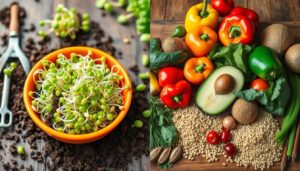
Sprout Food vs Whole Food: A Comprehensive Comparison
Regarding nutritional comparison, sprout food and whole food are quite different. Sprout food is packed with enzymes, vitamins, and minerals. On the other hand, whole food offers a wide range of macronutrients and fiber. Knowing these differences helps us make better choices for our diet and lifestyle.
It is essential to consider the health benefits of each food type. Sprout food is rich in antioxidants and has anti-inflammatory properties. Whole food, on the other hand, gives us long-lasting energy and helps with digestion. We can enjoy their unique nutritional benefits by eating sprouts and whole foods.
Here are some key points to consider when comparing sprout food and whole food:
- Sprout food is higher in enzymes and vitamins
- Whole food provides a broader range of macronutrients and fiber
- Sprout food has higher antioxidant levels and anti-inflammatory properties
- Whole food supports healthy digestion and provides sustained energy
In conclusion, the sprout food vs. whole food debate is about what we prefer and our dietary needs. By understanding the nutritional comparison and health benefits, we can make wise choices and enjoy a balanced and nutritious diet.
Digestibility and Nutrient Absorption
Proper digestion and nutrient absorption are key to good health and avoiding chronic diseases. Food’s digestibility dramatically affects how much we can absorb from it. Enzyme activity, nutrient bioavailability, and how food impacts digestion are all important.
Enzyme Activity in Sprouts
Enzymes in sprouts help break down complex nutrients into simpler ones, making it easier for our bodies to use them efficiently.
Bioavailability of Nutrients
The bioavailability of nutrients in sprouts and whole foods can differ significantly. Phytic acid, oxalic acid, and fiber can impact how well we absorb nutrients, so it’s essential to consider these when assessing food digestibility.
Digestive Impact Comparison
Comparing sprouts and whole foods shows sprouts have more enzyme activity, which helps digestion. Whole foods have more fiber, which can slow digestion but also have health benefits.
The table below highlights the main differences in digestibility and nutrient absorption between sprouts and whole foods:
| Food Type | Enzyme Activity | Bioavailability of Nutrients | Digestive Impact |
| Sprout Food | High | High | Easy to digest |
| Whole Food | Low | Variable | Slower digestion |
In conclusion, knowing what affects digestibility and nutrient absorption is vital. By examining enzyme activity, nutrient bioavailability, and digestive impact, we can see the benefits of sprouts and whole foods in our diet.
Health Benefits and Potential Drawbacks
It is key to look into sprouted and whole foods’ health benefits and drawbacks. We need to check their nutritional value, ability to digest, and any allergens or toxins. Both offer health perks like reduced risk of chronic diseases and improved nutrient intake. But they also have downsides, like nutritional deficiencies, if not balanced correctly.
Eating a mix of sprout food and whole food can bring many health benefits. These include:
- Improved digestion
- Boosted immune system
- Increased energy levels
But, there are also potential downsides. These include:
- Allergic reactions
- Foodborne illnesses
- Nutritional deficiencies
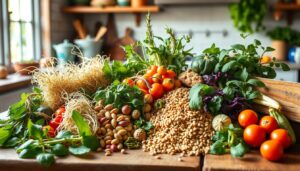
It is essential to know these risks. We should handle and prepare food safely. This way, we can enjoy the benefits while avoiding the drawbacks. Making wise diet choices can help us stay healthy and avoid nutritional gaps.
A balanced diet is crucial to get the most benefits and avoid risks. Here’s how to achieve it:
- Consult with a healthcare professional or registered dietitian
- Read food labels and understand nutritional content
- Prepare food safely and hygienically
| Food Type | Health Benefits | Potential Drawbacks |
| Sprout Food | High in antioxidants, improved digestion | Potential for foodborne illnesses, allergic reactions |
| Whole Food | Rich in fiber, essential nutrients | Nutritional deficiencies, if not correctly balanced |
The cost comparison between sprouted food and whole food in 2025 will likely depend on factors like production methods, demand, and supply chain efficiency. Sprouted foods, which involve soaking and germinating seeds, grains, or legumes, often require more labor, time, and controlled conditions (e.g., temperature and humidity) than whole foods. This additional processing can make sprouted foods more expensive. However, costs may decrease as technology advances and sprouted food production scales up, narrowing the price gap.
Whole foods, such as unprocessed grains, fruits, and vegetables, are generally more affordable due to their more straightforward production and longer shelf life. However, organic or specialty whole foods may still carry a premium. In 2025, sustainability trends could also impact costs. Sprouted foods, often marketed as nutrient-dense and eco-friendly, might appeal to environmentally conscious consumers willing to pay more. Conversely, whole foods could become more expensive if climate change affects crop yields or supply chains.
Sprout Food vs Whole Food: Exploring the Health Differences.
Ultimately, the cost comparison will vary by product type, brand, and region. For budget-conscious consumers, whole foods may remain the more economical choice, while those prioritising enhanced nutrition or sustainability might opt for sprouted options despite the higher price. As awareness grows, the market may see more affordable sprouted food options, making them accessible to a broader audience.
| Food Type | Cost | Accessibility | Storage Requirements |
| Whole Foods | Affordable | Widely available | Minimal |
| Sprout Foods | More expensive | Limited availability | Specialised |
Environmental Impact and Sustainability
Looking into sprout food and whole food in our diets is key. We must think about their environmental impact and sustainability. The way food is made, processed, and shipped affects our planet. Knowing how Sprout and Whole Foods stack up in these areas is essential.
The carbon footprint of sprout food and whole food is a big deal. It shows the greenhouse gas emissions from making, moving, and storing these foods. Sustainability is also vital. This means that our food choices can last for a long time. By choosing sustainable options, we help the planet and support a greener food culture.
Carbon Footprint Analysis
Studies show that sprouts and whole foods have a lower environmental impact than many. Sprout food is often better because it grows faster and needs less transport. Here’s a quick look at their carbon footprints:
| Food Type | Carbon Footprint (kg CO2e/kg) |
| Sprout Food | 0.5 |
| Whole Food | 1.2 |
Water Usage Comparison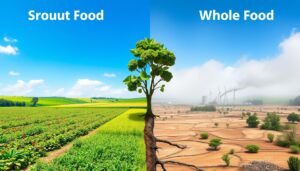
Water usage is another significant factor. Sprout food usually needs less water, thanks to methods like hydroponics. Whole food, on the other hand, uses more water for growing, processing, and shipping.
In short, it is crucial to consider the environmental impact and sustainability of sprouted and whole foods. By choosing foods with a smaller carbon footprint and less water use, we help the planet, making our food choices better for the environment.
Making the Right Choice for Your Diet
Choosing between sprout food and whole food depends on your dietary goals. You might want to lose weight, gain muscle, or stay healthy. Also consider your lifestyle, like your daily routine and what you eat.
Don’t forget about budget planning. Both sprout food and whole food can fit your budget. Here are some budget-friendly tips:
- Plan your meals to save money and reduce waste
- Buy seasonal produce for better prices
- Freeze items you buy in bulk for later
You can choose wisely by considering your dietary goals, lifestyle considerations, and budget planning. It’s about finding a balance that fits your needs and tastes.
The choice between sprout food and whole food depends on you. Think about your dietary goals, lifestyle considerations, and budget planning. This way, you can pick what’s best for your health and happiness.
| Dietary Consideration | Sprout Food | Whole Food |
| Dietary Goals | High in nutrients, supports weight loss | Rich in fiber, supports healthy digestion |
| Lifestyle Considerations | Easy to incorporate into busy lifestyles | Requires more meal planning and preparation |
| Budget Planning | It can be more expensive than Whole Foods | Generally more affordable than Sprout Food |
Best Practices for Incorporating Both Food Types
Understanding incorporation strategies is crucial when mixing sprouts and whole foods into your diet. It’s essential to plan a meal to balance their nutritional benefits. This will ensure your diet is well-rounded and supports your health.
Start by learning nutrition tips for sprout food and whole food. Try adding sprouts to salads or using whole foods as meal bases. Here are some tips to begin with:
- Incorporate a variety of sprouts into your diet, such as broccoli, alfalfa, and mung beans
- Use whole foods like brown rice, quinoa, and whole wheat as a base for your meals
- Experiment with different meal planning techniques, such as meal prep or batch cooking
Using these incorporation strategies and nutrition tips, you can craft a balanced and nutritious diet. Always aim for variety and balance. Don’t hesitate to explore new options. With creativity and planning, you can fully benefit from sprout food and whole food.
Here is a sample meal plan that incorporates both sprout food and whole food:
| Meal | Food Type | Nutritional Benefits |
| Breakfast | Whole grain cereal with sprouts | High in fiber and protein |
| Lunch | Salad with entire foods and sprouts | Rich in vitamins and minerals |
| Dinner | Grilled chicken with roasted whole foods | High in protein and healthy fats |
Conclusion
Exploring sprouts and whole foods
Sprout Food vs Whole Food: Exploring the Health Differences.
Shows that they both have unique nutritional benefits. Sprouts are great for enzymes and nutrient absorption, while entire foods offer a wide range of nutrients and carbohydrates.
Choosing between sprouts and whole foods depends on your diet goals and lifestyle. It also matters how much you can spend on food. Each type has its benefits.
It’s important to mix both sprouts and whole foods in your diet. This way, you get the best of both worlds. It’s not about being perfect, but making choices that fit your needs.
Keep exploring Sprout Food and Whole Foods. Try new things and find what works best for you. Knowing the differences helps you make better choices for your health and taste. By exploring the health differences between sprouted and whole foods, you can tailor your diet for optimal wellness.
FAQ
What is the difference between sprouted food and whole food?
Sprout food is germinated seeds, grains, or legumes. Whole foods are unprocessed, unrefined, and nutrient-dense in their natural state.
What are the key characteristics of sprout food and whole food?
Sprout food is more nutrient-dense and easier to digest. It has more enzymes than whole food, which offers a balanced nutritional profile, including macronutrients, micronutrients, and complex carbohydrates.
How does the nutritional composition of sprout food differ from that of whole food?
Sprout food has more vitamins, minerals, and antioxidants. It also has more protein and fiber. Whole food, on the other hand, has a more diverse range of nutrients and a balanced macronutrient profile.
What factors affect the digestibility and nutrient absorption of sprout and whole foods?
Enzyme activity, bioavailability, and digestive impact are key factors. Sprout food has higher enzyme activity and better nutrient bioavailability. Whole food provides a more comprehensive and balanced nutrient profile.
What are the health benefits and potential drawbacks of incorporating sprouts and whole foods into one’s diet?
Sprouted and whole foods offer health benefits, such as improved digestion and reduced risk of chronic diseases. They also enhance nutrient absorption. However, if not balanced properly, they can cause potential drawbacks, such as allergic reactions, food safety concerns, and nutrient deficiencies.
How do the cost and accessibility of sprout food and whole food compare?
The cost and accessibility of sprout food and whole food vary. Whole food may be more readily available and affordable in some areas, while sprout food may require specialised sourcing and storage considerations.
What are the best practices for incorporating sprout and whole food into one’s diet?
A balanced mix of sprout food and whole food is best. Consider individual dietary goals, lifestyle, and budget. Meal planning, variety, and proper food
We can thrive by understanding sprout food vs whole food: exploring the health differences in our meals.
Ultimately, sprout food vs whole food: exploring the health differences helps us create a balanced diet.
In our quest to understand sprout food vs whole food: exploring the health differences, we enrich our health journeys.
By actively engaging with sprout food vs whole food: exploring the health differences, we can influence our dietary habits.
Our understanding of sprout food vs whole food: exploring the health differences supports healthier lifestyle choices.
The sprout food vs whole food: exploring the health differences can serve as a guide for nutritional literacy.
Exploration of sprout food vs whole food: exploring the health differences enhances our meal choices.
As we analyze the sprout food vs whole food: exploring the health differences, we can better meet our dietary needs.
Through understanding sprout food vs whole food: exploring the health differences, we can boost our nutrition.
In our analysis of sprout food vs whole food: exploring the health differences, we can make tailored choices.
Evaluating sprout food vs whole food: exploring the health differences allows us to prioritize our health goals.
As we reflect on sprout food vs whole food: exploring the health differences, we can optimize our health journeys.
By appreciating sprout food vs whole food: exploring the health differences, we can enhance our dietary experiences.
Engaging with sprout food vs whole food: exploring the health differences promotes nutritional awareness.
Our focus on sprout food vs whole food: exploring the health differences can inspire healthier choices.
Delving into sprout food vs whole food: exploring the health differences reveals exciting possibilities for health.
The exploration of sprout food vs whole food: exploring the health differences enriches our meal planning.
Highlighting the sprout food vs whole food: exploring the health differences enhances our dietary understanding.
As we navigate sprout food vs whole food: exploring the health differences, we deepen our nutritional knowledge.
The insights gained from sprout food vs whole food: exploring the health differences foster healthier lifestyles.
By reflecting on sprout food vs whole food: exploring the health differences, we can refine our nutritional strategies.
Engaging with sprout food vs whole food: exploring the health differences helps to sharpen our focus on nutrition.
Learning about sprout food vs whole food: exploring the health differences can empower our food choices.
Ultimately, sprout food vs whole food: exploring the health differences can inform our dietary preferences.
Through the lens of sprout food vs whole food: exploring the health differences, we see the importance of mindful eating.
As we critically assess sprout food vs whole food: exploring the health differences, we can align our diets with our health goals.
The conversation surrounding sprout food vs whole food: exploring the health differences can enhance our understanding of nutrition.
Our journey into sprout food vs whole food: exploring the health differences can lead to improved dietary choices.
The discussion of sprout food vs whole food: exploring the health differences is vital for promoting health awareness.
In comparing sprout food vs whole food: exploring the health differences, we can better understand their roles in nutrition.
Our exploration of sprout food vs whole food: exploring the health differences reveals fascinating insights.
Understanding sprout food vs whole food: exploring the health differences can guide us toward healthier eating habits.
By examining sprout food vs whole food: exploring the health differences, we gain insight into how each can impact our health.
As we analyze sprout food vs whole food: exploring the health differences, we discover the nuances of their nutritional profiles.
The rising popularity of sprout food vs whole food: exploring the health differences brings attention to their respective benefits.
In our journey of sprout food vs whole food: exploring the health differences, we can appreciate how these foods contribute to our overall wellbeing.
Understanding the differences between sprout food vs whole food: exploring the health differences is essential for making informed dietary choices.

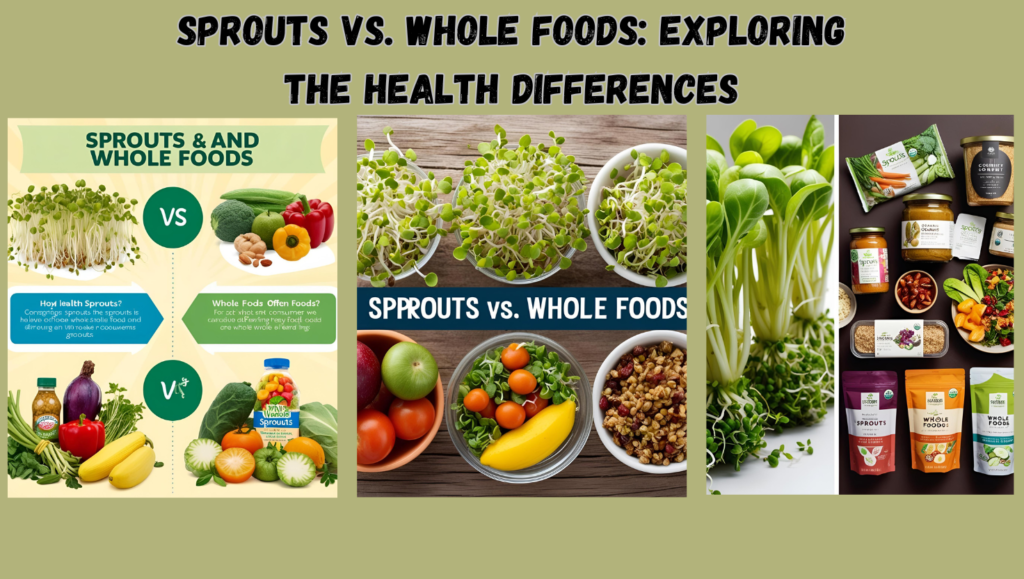

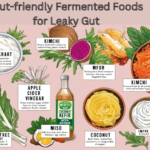
Pingback: 7 Best Healthy Habits to Boost Your Energy Now